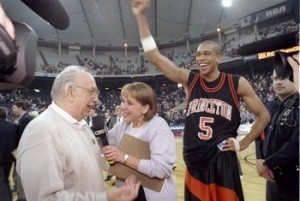Posted by JWeill on February 3rd, 2011

Past Imperfect is a new series focusing on the history of the game. Every Thursday, RTC contributor JL Weill (@AgonicaBoss) highlights some piece of historical arcana that may (or may not) be relevant to today’s college basketball landscape. This week: the sine-wave career arc of Doughnut Man.
It’s still one of the NCAA tournament’s most indelible moments: disheveled Princeton coach Pete Carril grinning in disbelief moments after his backdoor-cutting Tigers stunned defending national champion UCLA in the first round of the 1996 NCAA tournament. Replayed over and over through the years, the moment resonates because it captures the essence of what college basketball’s great March tradition is all about: little guy beats big guy, Cinderella at the dance, etc. But lost in all those good vibes for the white-haired coaching legend is that the other side in that game, the losing coach seen congratulating Carril on his career-defining victory, in its own way represents college basketball, too. In many ways, perhaps more so.

Pete Carril and Sydney Johnson celebrate the win over UCLA.
No one fathomed at the time that the upset loss would be Jim Harrick’s last as head coach of the UCLA Bruins. A year removed from the school’s first national title in two decades, flush with a contract extension, with a bevy of blue chip recruits on the verge of replenishing his team’s talent level for years to come, Harrick looked to have it all working. Then, in the course of a few months, it was all over. Harrick was out. Assistant Steve Lavin, with no head coaching experience at all, was in as interim coach.
How did it all go south so quickly? The answer is a tale of two coaches, of lies and deception, of risks taken and undying myths writ large. It’s an ugly story, without much grace and lacking humility. It is, in short, the story of college basketball at the highest levels.
* * *
It is amusing now to go back and look at statements of outrage former coach Jim Harrick made about his abrupt dismissal by UCLA in 1996. At the time, Harrick was the man who’d brought UCLA back from the ether. The West Virginian had been all smiles hoisting the national championship trophy along with Ed O’Bannon, Tyus Edney and the victorious Bruins. And rightfully so. Harrick had taken a job a slew of previous coaches had tried to tame and done the only thing he’d been hired to do: win a national title again. Favorite sons Walt Hazzard, Gary Cunningham and Larry Farmer didn’t do it. Future coaching legends Gene Bartow and Larry Brown couldn’t do it, either. But the onetime UCLA assistant – the guy who never even played college basketball – did it. And he did it his own way, with style.
Read the rest of this entry »
| past imperfect, Regular Features
| Tagged: alabama, ben howland, bill walton, cameron dollar, chapman college, charles o'bannon, dan gadzuric, don mclean, ed o'bannon, gary cunningham, gene bartow, gene keady, georgia, jaron rush, jelani mccoy, jim harrick, john wooden, larry brown, larry farmer, lew alcindor, lorenzo romar, lou carnasecca, mark gottfried, mark madsen, mike krzyzewski, murray state, norm roberts, northern arizona, pepperdine, pete carril, pittsburgh, princeton, purdue, ray young, rhode island, san diego, st johns, st louis, stanford, steve lavin, toby bailey, tyus edney, ucla, unlv, walt hazzard, washington
Share this story












































